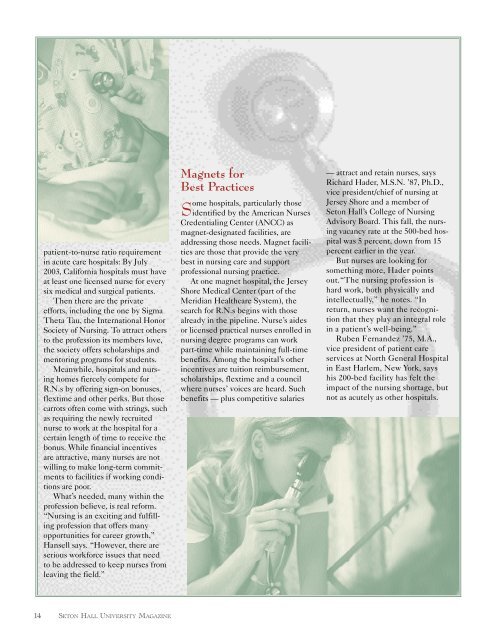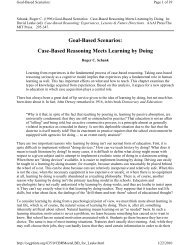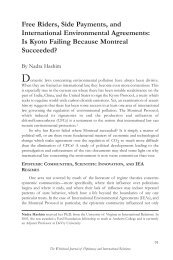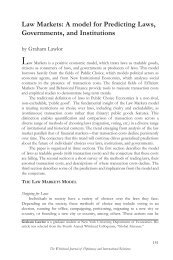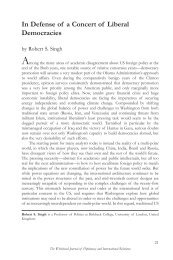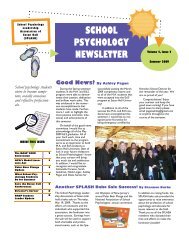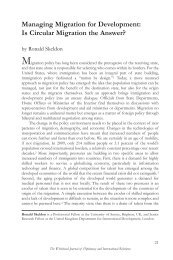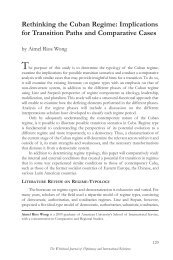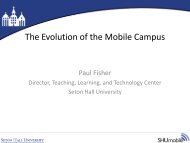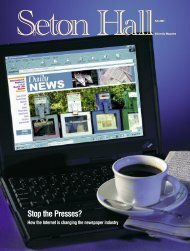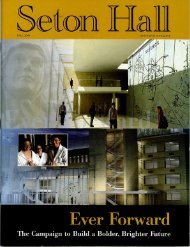Seton Hall Magazine, Winter 2003 - Seton Hall University
Seton Hall Magazine, Winter 2003 - Seton Hall University
Seton Hall Magazine, Winter 2003 - Seton Hall University
You also want an ePaper? Increase the reach of your titles
YUMPU automatically turns print PDFs into web optimized ePapers that Google loves.
patient-to-nurse ratio requirement<br />
in acute care hospitals: By July<br />
<strong>2003</strong>, California hospitals must have<br />
at least one licensed nurse for every<br />
six medical and surgical patients.<br />
Then there are the private<br />
efforts, including the one by Sigma<br />
Theta Tau, the International Honor<br />
Society of Nursing. To attract others<br />
to the profession its members love,<br />
the society offers scholarships and<br />
mentoring programs for students.<br />
Meanwhile, hospitals and nursing<br />
homes fiercely compete for<br />
R.N.s by offering sign-on bonuses,<br />
flextime and other perks. But those<br />
carrots often come with strings, such<br />
as requiring the newly recruited<br />
nurse to work at the hospital for a<br />
certain length of time to receive the<br />
bonus. While financial incentives<br />
are attractive, many nurses are not<br />
willing to make long-term commitments<br />
to facilities if working conditions<br />
are poor.<br />
What’s needed, many within the<br />
profession believe, is real reform.<br />
“Nursing is an exciting and fulfilling<br />
profession that offers many<br />
opportunities for career growth,”<br />
Hansell says. “However, there are<br />
serious workforce issues that need<br />
to be addressed to keep nurses from<br />
leaving the field.”<br />
14 SETON HALL UNIVERSITY MAGAZINE<br />
Magnets for<br />
Best Practices<br />
ome hospitals, particularly those<br />
Sidentified by the American Nurses<br />
Credentialing Center (ANCC) as<br />
magnet-designated facilities, are<br />
addressing those needs. Magnet facilities<br />
are those that provide the very<br />
best in nursing care and support<br />
professional nursing practice.<br />
At one magnet hospital, the Jersey<br />
Shore Medical Center (part of the<br />
Meridian Healthcare System), the<br />
search for R.N.s begins with those<br />
already in the pipeline. Nurse’s aides<br />
or licensed practical nurses enrolled in<br />
nursing degree programs can work<br />
part-time while maintaining full-time<br />
benefits. Among the hospital’s other<br />
incentives are tuition reimbursement,<br />
scholarships, flextime and a council<br />
where nurses’ voices are heard. Such<br />
benefits — plus competitive salaries<br />
— attract and retain nurses, says<br />
Richard Hader, M.S.N. ’87, Ph.D.,<br />
vice president/chief of nursing at<br />
Jersey Shore and a member of<br />
<strong>Seton</strong> <strong>Hall</strong>’s College of Nursing<br />
Advisory Board. This fall, the nursing<br />
vacancy rate at the 500-bed hospital<br />
was 5 percent, down from 15<br />
percent earlier in the year.<br />
But nurses are looking for<br />
something more, Hader points<br />
out.“The nursing profession is<br />
hard work, both physically and<br />
intellectually,” he notes. “In<br />
return, nurses want the recognition<br />
that they play an integral role<br />
in a patient’s well-being.”<br />
Ruben Fernandez ’75, M.A.,<br />
vice president of patient care<br />
services at North General Hospital<br />
in East Harlem, New York, says<br />
his 200-bed facility has felt the<br />
impact of the nursing shortage, but<br />
not as acutely as other hospitals.


